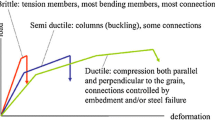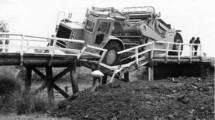Abstract
The monitoring of timber structures grew up in the late 1980 in the United States for the evaluation of the structural safety of bridges. After some timber structures collapsed in Europe in the last decade, the monitoring becomes more important: nowadays, it is used not only for bridges, but also especially for new buildings’ monitoring. The monitoring of historical timber structures is realized, until today, at the minimum, simply recording the variation of temperature and humidity and/or repeating the on-site inspection. The on-site inspection is considered as the most powerful non-destructive tool for the assessment of timber structures, but it shows its implied limit: it takes a snapshot of the timber structure conditions in a specific moment. Otherwise, the remote monitoring used for new structures, based on recent technologies and solutions, offers the possibilities of a continuous monitoring, allowing to see the effects that all possible external factors have on the mechanical behaviour of the structure and on its state of conservation. Some of the solutions realized for the monitoring of new constructions can be extended to the old timber structures, taking into account the peculiarity of historical ones that require to be preserved and maintained in safety conditions, as part of the World Cultural Heritage.



Similar content being viewed by others
References
Cruz H, Yeomans D, Tsakanika E et al (2013) Guidelines for the on-site assessment of historic timber structures. Int J Archit Herit. doi:10.1080/15583058.2013.774070
Kasal B, Anthony RW (2004) Advances in situ evaluation of timber structures. Prog Struct Eng Mater 6:94–103. doi:10.1002/pse.170
Tannert T, Dietsch P, Cestari CB, Kasal B (2012) Cost Action Fp1101—Assessment, Reinforcement And Monitoring Of Timber Structures. WCTE—World Conf. Timber Eng
Frühwald E, Serrano E, Toratti T et al (2007) Design of safe timber structures—How can we learn from structural failures in concrete, steel and timber? Report TVBK-3053. Division of Structural Engineering, Lund University
Bonamini G (1995) Restoring timber structures—inspection and evaluation. Lect. D3 Timber Eng. STEP 2—Des.—Details Struct. Syst. STEP/EUROFORTECH an Initiat. under EU Comett Program. 1st edn. pp D3/1–9
Bonamini G, Noferi M, Togni M, Uzielli L (2001) Manuale del legno strutturale—Vol. I—Ispezione diagnosi in opera. Carlo Mancosu Editore, Rome
Bonamini G, Noferi M, Togni M (2001) On-site grading of old timber members. In: Cestari CB (ed) Wooden Handwork/Wooden Carpentry Eur. Restor. Sites. Paris, pp 205–210
Ross RJ, Brashaw BK, Wang X, et al. (2004) Wood and timber: condition assessment manual. Madison-Winsconsin
Dietsch P, Köhler J (2011) Methods for the assessment of timber structures—Task Group Report—Cost Action E55 Modelling of performance of timber structures
Bohumil K, Tannert T (2011) In situ assessment of structural timber. p 132
Ceccotti A, Togni M (1996) NDT on ancient timber beams: assessment of strength/stiffness properties combining visual and instrumental methods. In: 10th International Symposium Nondestructive Testing of Wood
Feio A, Lourenço P, Machado J (2007) Non-destructive evaluation of the mechanical behavior of chestnut wood in tension and compression parallel to grain. Int J Archit Herit 1:272–292. doi:10.1080/15583050701300475
Íñiguez G, Arriaga F, Esteban M, et al. (2010) In situ non-destructive density estimation for the assessment of existing timber structures. WCTE 2010—World Conf. Timber Eng
Cavalli A, Togni M (2013) How to improve the on-site MOE assessment of old timber beams combining NDT and visual strength grading. J Nondestruct Test Eval. doi:10.1080/10589759.2013.764424
Sousa HS, Sørensen JD, Kirkegaard PH et al (2013) On the use of NDT data for reliability-based assessment of existing timber structures. Eng Struct 56:298–311. doi:10.1016/j.engstruct.2013.05.014
UNI 11119:2004 (2004) Cultural Heritage—wooden artefacts. Load-bearing structures. On site inspections for the diagnosis of timber members
USDA Forest Service (1990) The timber bridge initiative, fiscal year 1990 status report
Ritter MA, Geske EA, McCutcheon WJ, et al. (1991) Methods for assessing the field performance of stress-laminated timber bridges. In: International Timber Engineering Conference London, pp 319–326
Wacker JP, Calil CJ (2004) Pennsylvania hardwood timber bridges: Field performance after 10 Years. In: American Society for Nondestructive Testing (ed) Proc. Structural Mater. Technol. Buffalo, New York, pp 222–227
Wang X, Wacker JP, Morison AM, et al. (2005) Nondestructive assessment of single-span timber bridges using a vibration-based method. 17
Tannert T, Berger R, Müller A (2011) Remote moisture monitoring of timber bridges: a case study. In: 5th International Conference on Structural Monitoring Intelligent Infrastructures. Cancùn, Mexico, pp 1–9
Moore J, Patterson R (2009) How to stop the rot? Continuous monitoring of short span timber bridges. Institution of Engineers Australia NSW Regional Convention, Grafton, pp 163–170
Kudela J (1996) Detection of stresses in wood by the reflection photoelasticity. In: 10th International Symposium on Nondestructive Testing of wood. p 401
Jankowski LJ, Jasieńko J, Nowak TP (2010) Experimental assessment of CFRP reinforced wooden beams by 4-point bending tests and photoelastic coating technique. Mater Struct 43:141–150. doi:10.1617/s11527-009-9476-0
Oscarsson J, Olsson A, Enquist B (2010) Strain fields around a traversing edge knot in a spruce specimen exposed to tensile forces. WCTE 2010—World Conf. Timber Eng.—World Conf. Timber Eng
Jeong GY (2008) Tensile properties of Loblolly Pine strands using digital image correlation and stochastic finite element method
Meihua L, Dongai W (2011) Surface deformation measurements of a finger-joint timber by object-oriented technique and digital speckle image correlation. In: International Conference on Electrical Information and Control Engineering pp 3645–3648. doi:10.1109/ICEICE.2011.5777861
Dubois F, Méité M, Pop O, Absi J (2012) Characterization of timber fracture using the digital image correlation technique and finite element method. Eng Fract Mech 96:107–121. doi:10.1016/j.engfracmech.2012.07.008
Henke K, Pawlowski R, Schregle P, Winter S (2012) Digital Image Processing in the Monitoring of Wide-span Timber Roof Structures. World Conf. Timber Eng. Auckland, pp 200–203
Abels M (2011) Assessment matrix for timber structures—basics for standardized building checks. Bouwstenen Publicatieburo, Eindhoven
Uzielli L, Cocchi L, Mazzanti P et al (2012) The deformometric kit: a method and an apparatus for monitoring the deformation of wooden panels. J Cult Herit 13:94–101. doi:10.1016/j.culher.2012.03.001
Knight B, Thickett D (2007) Determination of response rates of wood objects to fluctuating humidity in historic properties. Mus Microclim National M pp 85–88
Bratasz Ł, Kozłowski R, Camuffo D, Pagan E (2007) Impact of indoor heating on painted wood: monitoring the altarpiece in the church of Santa Maria Maddalena in Rocca Pietore, Italy. Stud Conserv 210:199–210
Goli G, Fioravanti M, Busoni S, et al. (2012) Measurement and modelling of mass and dimensional variations of historic violins subjected to thermo-hygrometric variations: The case study of the Guarneri “del Gesù” violin (1743) known as the “Cannone.”J Cult Herit 13:154–160. doi:10.1016/j.culher.2012.04.007
Brischke C, Hansson EF (2011) Modeling biodegradation of timber—dose-response models for above-ground decay and its climate-dependent variability. In: Int Conf Struct Heal Assess Timber Struct
Dietsch P, Gamper A, Merk M, Winter S (2012) Building climate—long-term measurements to determine the effect on the moisture gradient in large-span timber structures. In: Proc. Iternational Counc. Res. Innov. Build. Constr. Work. Comm. W18—Timber Struct. Meet. 45, Växjö, Sweden. pp 1–14
N’Guyen TA, Angellier N, Caré S et al (2013) Approaches to the moisture content monitoring in timber elements: development of a resistive method. Adv Mater Res 778:335–341
Jorge L, Dias A (2013) X-Lam panels in swimming-pool building—monitoring the environment and the performance. Adv Mater Res 778:779–785
Leicester RH (2001) Engineered durability for timber construction. Prog Struct Eng Mater 3(3):216–227
Ribeiro D, Garrett JA, Duarte S, et al. (2012) Probability of damage in timber structures by monitoring of biological activity. ICDS12-Iternational Conf. Durable Struct. from Constr. to Rehabil
Oliver-Villanueva JV, Abián-Pérez MA (2012) Advanced wireless sensors for termite detection in wood constructions. Wood Sci Technol 47:269–280. doi:10.1007/s00226-012-0485-8
Doudak G, McClure G, Smith I et al (2005) Monitoring structural response of a wooden light-frame industrial shed building to environmental loads. J Struct Eng 131:794. doi:10.1061/(ASCE)0733-9445(2005)131:5(794)
Morris H, Worth M, Omenzetter P (2011) Monitoring modern timber structures and connections. In: Int. Conf. Struct. Heal. Assess. Timber Struct
Lanata F (2013) An on-going monitoring project of a new timber structure. Adv Mater Res 778:757–764
Moore JC (2009) Monitoring timber beam bridges for structural health. Master of Resource Science Thesis
Metelli G, Giurani E, Marchina E (2013) The repair of timber beams with controlled-debonding steel plates. Adv Mater Res 778:588–595
Henriques MJ, Mateus PB, Palma P, Cruz H (2008) Modelling the bahaviour of a large span glulam arch of Atlantico Pavillon. In: 13 th Symp. Deform. Meas. Anal. Lisbon, pp 1–11
Nadine D, Montaruli E (2008) Service life analysis of marine structures made of tropical hardwoods. WCTE—world Conf. Timber Eng. Miyazaki, Japan, pp 258–265
ENV 1995-2 Eurocode 5—Design of timber structure
Branco JM, Cruz PJS, Piazza M, Varum H (2008) Procedures field load tests on a Queen-post timber truss. In: Sixth Int. Conf. Struct. Anal. Hist. Constr. Bath, pp 507–514
Munafò P, Grilli M (2005) Il rispetto del costrutto salvaguardando i cinematismi originari di rottura. Conserv. Hist. wooden Struct. Florence, Italy, pp 51–62
Cavalli A, Togni M (2013) The influence of routed grooves on the bending behavior of old timber beams. Adv Mater Res 778:393–401
ICOMOS (1999) Principles for the preservation of historic timber structures
Author information
Authors and Affiliations
Corresponding author
Rights and permissions
About this article
Cite this article
Cavalli, A., Togni, M. Monitoring of historical timber structures: state of the art and prospective. J Civil Struct Health Monit 5, 107–113 (2015). https://doi.org/10.1007/s13349-014-0081-8
Received:
Revised:
Accepted:
Published:
Issue Date:
DOI: https://doi.org/10.1007/s13349-014-0081-8




